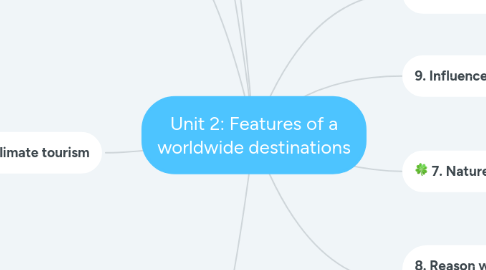
1. 5. Time Zones
1.1. Divided into twenty-four time zones
1.1.1. 15 degrees longitude apart
1.1.2. Each equal to an hour different
1.2. GMT - Greenwich Mean Time
2. 1.features of worldwide destinations
2.1. the character of their own
2.2. accessible location for the mass market
2.3. information services
2.4. accommodation and catering facilities
2.5. a range of visitor attractions
2.6. shopping facilities
2.7. enough parking spaces
3. 2.latitude & longitude
3.1. Latitude
3.1.1. indicate distance away from the equator, in both Northern and Southern hemispheres
3.1.2. parallel to the Equator and to each other
3.1.3. divides the globe into Northern and Southern Hemispheres.
3.2. longtitude
3.2.1. indicate a location's posituion East or West of Greenwich
4. 3.climate tourism
4.1. Types of Climate tourism
4.1.1. Equatorial
4.1.1.1. hot, wet and humid all year
4.1.2. Tropical
4.1.2.1. no cold season but summer rain
4.1.3. tropical Monsoon
4.1.3.1. no cold season but heavy summer rain
4.1.4. Tropical desert
4.1.4.1. no cold season and negligible rain
4.1.5. Warm temperate
4.1.5.1. hot dry summer, cool wet winter
4.1.6. Cool temperate
4.1.6.1. cold winter,hot summer, even rainfall
4.1.7. Arctic
4.1.7.1. harsh cold winter with snow,cool summer with rain
4.1.8. Polar
4.1.8.1. snow and ice prevail for most of the year
4.2. influence of climate on tourism
4.2.1. on season
4.2.1.1. a time of year that is the busiest or most popular for a specitfic activity
4.2.2. off season
4.2.2.1. a time of year when a particular activity is not engaged in
5. 4. World climate zones
5.1. Tropical climates
5.1.1. humid => no winter
5.1.2. near equator
5.1.3. temp: high/ heavy rain
5.1.4. Tropical Rainforest
5.1.4.1. Closest to equators
5.1.4.2. Rainfall all year
5.1.5. Tropical Savanna
5.1.5.1. Distinct dry season
5.1.5.2. Caribbean
5.1.5.3. Mexico
5.1.5.4. Miami
5.2. Dry climate
5.2.1. Deserted areas
5.2.1.1. very dry, less than inches of rain per year
5.3. The Mediteranean
5.3.1. Hot temp in summer/ dropping during mild winters
5.3.2. Hot, dry summer/ cool, wet winters
5.3.2.1. ideal conditions for tourists
5.4. Polar climates
5.4.1. Subarctic, tundra, and ice cap climates.
5.4.1.1. Tourism => hunting/ fishing/ camping, naturalist-related like animals
5.4.2. Arctic and Antarctica
5.4.2.1. Tourism is limited/ very short season
6. 6. DST - Daylight Saving Time
6.1. Appear in certain months of the year in certain countries
6.2. Change in time to lengthen evening daylight in summer by setting the clocks an hours ahead
7. 9. Influence of physical feature
8. 7. Nature Of Destinations
8.1. A destination is perishable
8.1.1. All destinations have a carrying capacity
8.1.2. Carrying Capacity is the max number of people that may visit a tourist attraction at the same time to prevent destruction or physical, economic, socio-culture economic and unacceptable decrease in the quality of visitor's satisfaction
